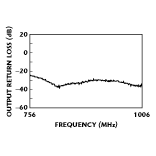Low Cost LNAs for 900 MHz Cell Site Applications
Aethercomm Inc.
San Marcos, CA
A new line of low noise amplifiers (LNA) for use in worldwide cell sites has been developed. The celLNA series amplifiers were designed to be used as front ends for cell site filters. All of the amplifiers operate from 806 to 956 MHz and can be used in AMPS, Narrowband AMPS, 800 MHz CDMA, Total Access Communications System, Nordic Mobile Telephone and GSM applications.
The amplifiers feature gains ranging from 15 to 37 dB, noise figures of 0.8 to 1.2 dB and output third-order intercept points (OIP3) approaching 50 dBm. Worst-case input and output return loss is 20 dB with typical values exceeding 24 dB. The amplifiers operate from 5 to 15 V DC depending on the system application. A temperature-compensated version that has less than ±0.2 dB gain variation from –40° to +85°C is part of the amplifier series.
Performance Characteristics
There are three amplifiers in the series. The model celLNA1 LNA is the lowest noise amplifier at 0.8 dB. It also features an OIP3 of 38 dBm, a typical gain of 34 dB and a gain variation of less than ±0.25 dB from –35° to +85°C. The celLNA1 LNA is supplied in a 1.5" x 3.0" package, but can be repackaged for custom applications.
The model celLNA2 amplifier has a maximum gain of 37 dB, but that figure can be adjusted for different applications. This amplifier offers an OIP3 of 47 dBm at 25°C with a noise figure of 1.1 dB. However, it can be modified for an OIP3 of 50 dBm. The celLNA2 LNA has nominal input/output return losses of 25 and 30 dB, respectively, at 25°C. It has an input IP3 of 11 dBm at the maximum gain value, which can be increased with a reduction in the gain for the 15 dB gain model. The amplifier’s 1 dB compression point is 27 dBm. The celLNA2 LNA measures 2.0" x 3.5", but the size can be reduced if required.
The use of proprietary techniques and the latest technologies have resulted in very low noise figures and outstanding OIP3s for the celLNA2 amplifier. Plots of the unit’s maximum gain and input and output return losses are shown in Figures 1 , 2 and 3 , respectively. These data show broadband performance from 756 to 1006 MHz. The gain response for this amplifier has been optimized for the 824 to 849 MHz AMPS system.



The model celLNA3 amplifier is a temperature-compensated version of the celLNA2 LNA. This amplifier maintains a gain variation of < ±0.2 dB from –40° to +85°C. Figure 4 shows the amplifier’s response from –35° to +25°C, indicating a gain variation of 0.15 dB. Figure 5 shows the gain change from 25° to 85°C, where the gain variation over temperature is almost indistinguishable.

 In addition, a line of LNAs has been developed for PCS sites that operates from 1710 to 1910 MHz. The pcsLNA series LNAs are based on the same design architecture used for the celLNA series amplifiers. They offer noise figures from 0.8 to 1.1 dB with a nominal OIP3 of 49 dBm. Maximum achievable gain is 30 dB, and input and output return losses are greater than 24 dB. These LNAs also can be temperature compensated for < ±0.2 dB gain variation from –40° to +85°C. The pcsLNA series amplifiers can be used in PCS, Digital Communications System, Digital European Cordless Telecommunications and Personal Handyphone systems.
In addition, a line of LNAs has been developed for PCS sites that operates from 1710 to 1910 MHz. The pcsLNA series LNAs are based on the same design architecture used for the celLNA series amplifiers. They offer noise figures from 0.8 to 1.1 dB with a nominal OIP3 of 49 dBm. Maximum achievable gain is 30 dB, and input and output return losses are greater than 24 dB. These LNAs also can be temperature compensated for < ±0.2 dB gain variation from –40° to +85°C. The pcsLNA series amplifiers can be used in PCS, Digital Communications System, Digital European Cordless Telecommunications and Personal Handyphone systems.
Pricing for the celLNA1, celLNA2 and celLNA3 is $75, $95 and $99, respectively, in 1000-piece quantities. Delivery is 120 days (ARO) with partial deliveries beginning in 45 days. Additional information may be obtained from the company’s Web site at www.aethercomm.com.
Aethercomm Inc.,
San Marcos, CA
(760) 471-9117.
